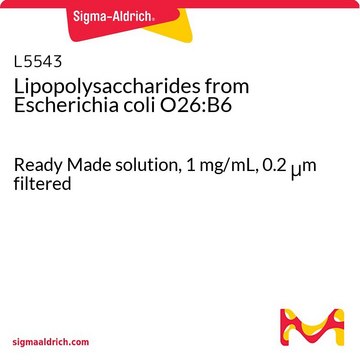Key Documents
L6529
Lipopolysaccharides from Escherichia coli O55:B5
γ-irradiated, BioXtra, suitable for cell culture
Synonim(y):
LPS
About This Item
Polecane produkty
pochodzenie biologiczne
Escherichia coli (O55:B5)
Poziom jakości
sterylność
γ-irradiated
linia produktu
BioXtra
Postać
lyophilized powder
oczyszczone przez
gel-filtration chromatography
metody
cell culture | mammalian: suitable
zanieczyszczenia
<3% Protein (Lowry)
rozpuszczalność
H2O: 5 mg/mL, faintly hazy to hazy
temp. przechowywania
2-8°C
Szukasz podobnych produktów? Odwiedź Przewodnik dotyczący porównywania produktów
Opis ogólny
Zastosowanie
- to stimulate human PBMC to secrete cytokine.
- to stimulate wild type embryonic fibroblasts and mutants for the induction of phosphorylation of p56
- in the measurement of tumor necrosis factor-α levels and nuclear factor-κB p65 activities after stimulation
- in the stimulation of hamster lymphocytes in vitro
- to induce activated dendritic morphology in murine macrophage cell line in a study
Działania biochem./fizjol.
Rekonstytucja
Inne uwagi
produkt powiązany
Hasło ostrzegawcze
Danger
Zwroty wskazujące rodzaj zagrożenia
Zwroty wskazujące środki ostrożności
Klasyfikacja zagrożeń
Acute Tox. 2 Oral
Kod klasy składowania
6.1A - Combustible acute toxic Cat. 1 and 2 / very toxic hazardous materials
Klasa zagrożenia wodnego (WGK)
WGK 3
Temperatura zapłonu (°F)
Not applicable
Temperatura zapłonu (°C)
Not applicable
Środki ochrony indywidualnej
Eyeshields, Gloves, type N95 (US)
Certyfikaty analizy (CoA)
Poszukaj Certyfikaty analizy (CoA), wpisując numer partii/serii produktów. Numery serii i partii można znaleźć na etykiecie produktu po słowach „seria” lub „partia”.
Masz już ten produkt?
Dokumenty związane z niedawno zakupionymi produktami zostały zamieszczone w Bibliotece dokumentów.
Klienci oglądali również te produkty
Produkty
An overview of human microbiome research, workflow challenges, sequencing, library production, data analysis, and available microbiome reagents to support your research.
Poznaj strukturę, funkcję i różnorodne zastosowania lipopolisacharydów. Odkryj ich rolę w bakteriach, specyficzność serologiczną i potencjał badawczy.
Nasz zespół naukowców ma doświadczenie we wszystkich obszarach badań, w tym w naukach przyrodniczych, materiałoznawstwie, syntezie chemicznej, chromatografii, analityce i wielu innych dziedzinach.
Skontaktuj się z zespołem ds. pomocy technicznej




